The 165 acres of Schaefer Prairie is in south central Minnesota, and was bought by the Nature Conservancy in 1967 to preserve its natural resources. Although it was mowed for hay yearly in the first half of the century, it has never been plowed. It contains both wet and mesic habitat, making it a gem of diversity. I visited on 15 August, although this is a prairie with great treasures throughout the season. This area has been heavily drought stricken, as evidenced by the unusually low water table. I could have walked in dry tenners where in a normal year, high rubber boots would be required. Still, prairie plants in general have very deep root systems (2-20ft and deeper), and most species seem relatively unaffected.
Allium stellatum (Prairie onion) variations.
Asclepias incarnata (Swamp milkweed) x3, Andropogon gerardii (Big Bluestem) in a sea of same, and Artemisia ludoviciana (white sage).
Edited to reload photos

Comments
Richard T. Rodich
Re: Schaefer Prairie - Minnesota
Tue, 08/28/2012 - 12:50pmBrickellia (Kuhnia) eupatorioides (False boneset)
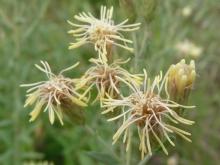
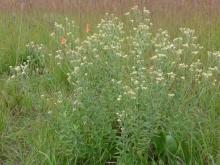
Bromus kalmii (Prairie Brome)

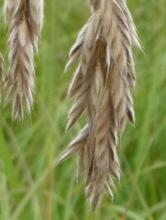

The invasive Canada thistle (Cirsium arvense) is present, but only at the edges of the prairie where it abuts with agricultural fields. Native wetland thistles are tall and have beautiful flowers at eye level, enhanced greatly by their intricate involucres (floral bracts).
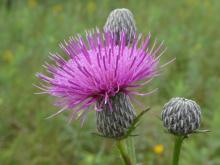

Cirsium muticum (Swamp thistle) x3, another Cirsium sp.
Richard T. Rodich
Re: Schaefer Prairie - Minnesota
Tue, 08/28/2012 - 1:34pmCypripedium candidum (Small White ladyslipper) was one that was severely hit by the drought and/or heat.
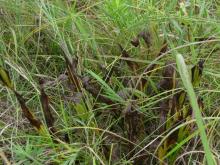
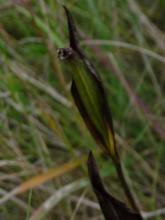
It was the very end of the Prairie clover season. Both the purple (Dalea purpurea) and whte (Dalea candida) forms are here, but I don't know them well enough to tell them apart without the flowers. I only found a few Purple Prairie clover still blooming. In the second pic, the little black upright "sausages" are the Prairie clover seedheads among Big Bluestem (Andropogon gerardii).
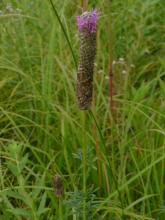
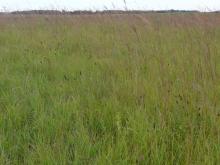
I usually find Desmodium canadensis (Canada Tick trefoil) with multiple stems, giving more of a shrub look to the species. Again at the tail end of bloom, here is a single stem plant. I have plenty of seed, if anyone would like any...
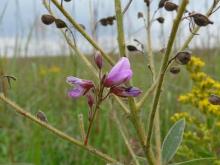

Dyssodia papposa (Dogweed) isn't that pretty and the flower is less than a half inch tall, but I'm always wondering what these are, so I did some research. Insects seem to love them.
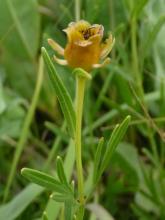
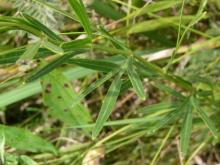
Richard T. Rodich
Re: Schaefer Prairie - Minnesota
Tue, 08/28/2012 - 1:59pmElymus canadensis (Canada Wild rye)
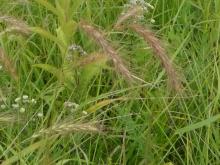
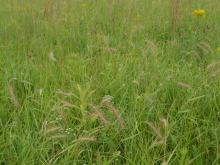
Gentiana andrewsii (Bottle gentian) is fairly common throughout Minnesota, but never in abundance.
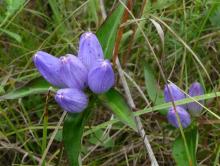
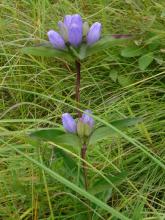

Helenium autumnale (Sneezeweed) is a single to few stemmed plant in the wild.
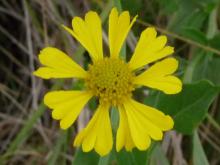
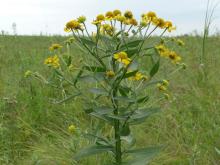
cohan (not verified)
Re: Schaefer Prairie - Minnesota
Wed, 08/29/2012 - 11:22amGreat views and great set of plants, Rick! I love the open spaces of natural prairie.. We get some prairie edge plants here in roadsides and pastures, but open grassland is not something that survives here without intervention, so any plants that take longer to establish do not make it this far ..
Cliff Booker
Re: Schaefer Prairie - Minnesota
Wed, 08/29/2012 - 12:57pmBrilliant trip report and images, Rick ... many thanks for posting.
Lori S. (not verified)
Re: Schaefer Prairie - Minnesota
Wed, 08/29/2012 - 7:07pmReally interesting, Rick! Neat to see Helenium autumnale in its natural habitat. The variation among Allium stellatum is quite amazing. Thanks for taking us along!
Richard T. Rodich
Re: Schaefer Prairie - Minnesota
Wed, 08/29/2012 - 7:11pmActually Cohan, in this area, land would be forested without periodic fires or some kind of human intervention. The prairie is managed with fire, and it is bordered on three of four sides by gravel roads, so controlled burning is relatively easy. I saw very little of the invasive sweetclover, and then only in its first year stage, so I think they have been doing a good job.
Thanks, Lori and Cliff. I only got through to "H" before I ran out of time and am only getting to finish the post now...
Richard T. Rodich
Re: Schaefer Prairie - Minnesota
Wed, 08/29/2012 - 8:17pmI haven't really delved into identifying all the Helianthus spp. that are native in Minnesota, a project for some later date. This is a "typical" one.
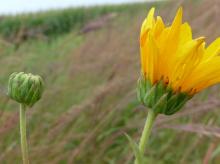
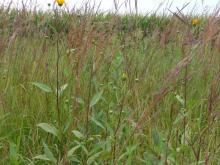
Lespedeza capitata (Round-headed Bushclover) makes a nice addition to dried "floral" arrangements. Weathered seedheads from the previous yeaar are shown in the last photo.
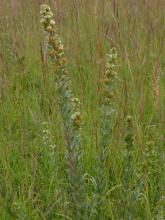
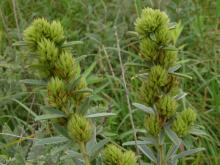
All the native Liatris spp. I have not yet mastered, either. They are often misidentified due to variation within the each species and the relative difficulty of ascertaining the differentiating features. But these I can be quite sure of:

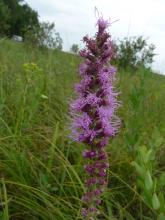
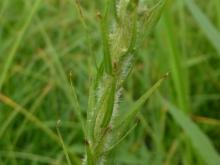
Liatris aspera (Rough Blazing Star) with Dalea sp. seedheads. Flowers are pink-lavender, and the white bracts will darken a bit with age. Pics 2 and 3 are Liatris pychnostachya (Prairie Blazing Star). It has one of the hairiest stems of all the liatris species.
Richard T. Rodich
Re: Schaefer Prairie - Minnesota
Wed, 08/29/2012 - 8:54pmMore liatris pics. These are probably Liatris ligulistylis (Showy Blazing Star).
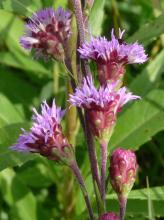
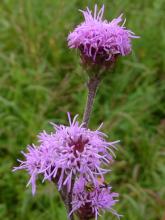
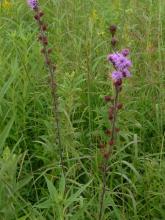
A trick I "invented" to highlight a plant where it would otherwise be lost in the surroundings: when the conditions are right, sometimes you can get your shadow to fall on only the subject. One pic with, one pic without.
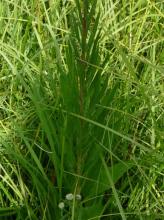
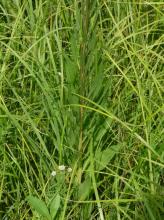
Not sure about this one, but I like it.
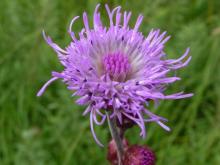
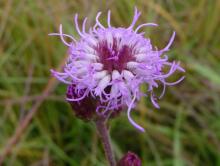
This one is probably Liatris punctata (Dotted Blazing Star).
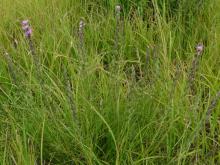

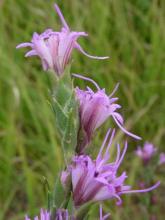
Richard T. Rodich
Re: Schaefer Prairie - Minnesota
Wed, 08/29/2012 - 9:35pmGreat Blue lobelia (Lobelia siphilitica) is only invasive in a garden setting.

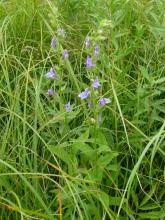
Lysimachia quadrifolia (Prairie Loosetrife) is abundant here, although fairly rare in the state. The last pic with the rounded seedpods.
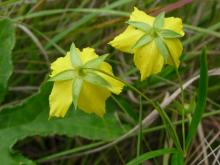
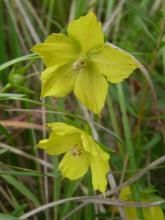
Purple Loostrife (Lythrum salicaria) is a terrible European invasive in wetlands all over the eastern US. Sweetclover in the upland prairie habitat can be bad, but not nearly as much, at least partly because it is a biennial. L. salicaria almost automatically displaces all the natives where ever it invades. We are extremely lucky it has not found Schaefer prairie... yet. Our native Lytrum species, Lytrum alatum (Winged Loostrife) has fewer, but larger flowers on shorter stalks.

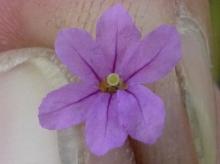
Richard T. Rodich
Re: Schaefer Prairie - Minnesota
Wed, 08/29/2012 - 10:28pmThe only flower I found still blooming of our native Beebalm (Monarda fistulosa). Not as full as usual, but shows the true light lavender color that I find more pleasing than the bright colors of the garden cultivars of M. didyma. Most plants at this time of year look like the second pic, a little tired and lots of seed heads.
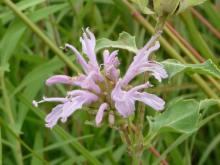
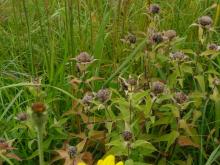
Pedicularis lanceolata (Swamp betony) is an interesting plant. The flowers tilt to one side and give a spiraling effect to the floral spike when viewed from above, even though the flowers point straight out from the stem.
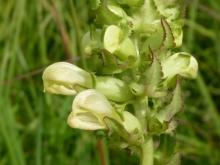
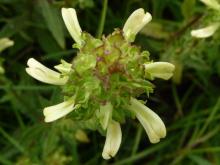
Silver Scurf pea (Pediomelum argophyllum) is way past bloom (see flowers here: http://nargs.org/smf/index.php?topic=455.msg18808#msg18808), but the leaves, heavily clothed with white hairs, make it a pleasant sight. A few Phlox pillosa var. fulgida (Downy phlox) still blooming.
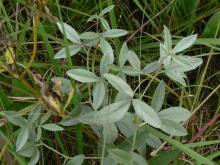

Rosa arkansana (Prairie rose) is always an unassuming plant in the prairie, an so is a joy to come across. The silver-gray Amorpha canescens (Leadplant) is also past bloom, but remains an integral part of prairie views.
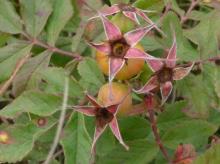
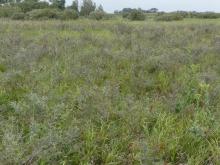
Richard T. Rodich
Re: Schaefer Prairie - Minnesota
Wed, 08/29/2012 - 10:43pmThis should be Pycnanthemum virginianum (Virginia Mountain mint), although I detect no mint odor at all. But the characteristics fit more with it than P. tenuifolium.
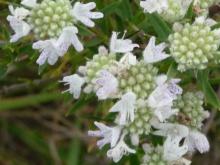
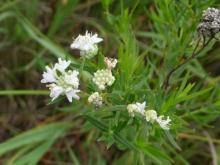
Prairie Cordgrass (Spartina pectinata) can grow almost as a monoculture, and in such a case can be a little dangerous to walk through since he leaves have sharp edges. But here it is quite benign. Big Bluestem is in the foreground of the second photo.


Scutellaria galericulata (Marsh skullcap) grows in the very wet parts with tufted sedges.
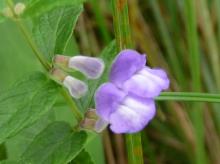

Several goldenrods grow here. These are the easy ones to identify, as the foliage is quite different from most goldenrods.
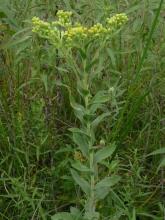
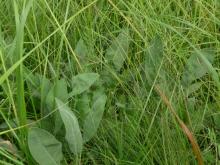
Stiff goldenrod (Solidago rigida) - second pic non-flowering stage, and the swamp loving Riddell's goldenrod (Solidago riddellii). Both are just beginning to bloom.
cohan (not verified)
Re: Schaefer Prairie - Minnesota
Wed, 08/29/2012 - 11:21pmMore great plants! Interesting to see which plants are similar to here, and which very different... I like the Pedicularis, simply because my only local species (that I've seen, at least) is pink..
So, several Liatris species all grow in close proximity? Interesting.. none in my immediate area, though I guess we have that situation with numerous Asters...
Goldenrods are mostly done here, at the least past their prime-- but of course we are much nearer to frost (any day, potentially) than you are, so while things continue to flower past frost, very few species trust all their seed potential to late good weather!
Interested in seeing your last post, which oddly shows in the summary when I'm replying, but did not come out properly and does not show in the thread apart from the first line...
Richard T. Rodich
Re: Schaefer Prairie - Minnesota
Wed, 08/29/2012 - 11:39pmYes, the different Liatris species grow amongst each other, although there seems to be some preference for moist to dry. None grow in the wet parts, of course, but L. pychnostachya grows in the more moist areas, then L. ligulistylis, then L. aspera, and L. punctata in the driest part.
I think you were reading my last post while I was in the midst of building it. At the most, I can post seven pics at a time, so I have to go back and add the rest via the modification button.
Richard T. Rodich
Re: Schaefer Prairie - Minnesota
Thu, 08/30/2012 - 12:01amThese Polygonum amphibium var. emersum (Swamp smartweed) have nice undulating leaves. In the second pic, the seed heads of Vernonia fasciculata (Prairie ironweed) are in the foreground and background. The ironweeds do seem to like a lot of moisture, despite their strong root systems.
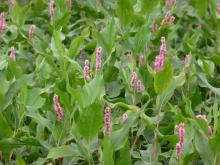
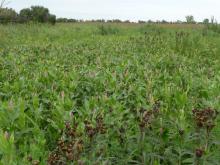
And one more prairie scene to end the album.
cohan (not verified)
Re: Schaefer Prairie - Minnesota
Thu, 08/30/2012 - 12:10amThe Vernonia are interesting.. Panayoti was just talking about the genus a bit on FB and his blog.. another genus I have not seen in person..
fleurbleue (not verified)
Re: Schaefer Prairie - Minnesota
Thu, 08/30/2012 - 2:19amWonderful to be allowed to discover your wild flora ! Many thanks Rick ;)
Trond Hoy
Re: Schaefer Prairie - Minnesota
Thu, 08/30/2012 - 9:04amRick, beautiful - and in no way similar to neither moonscape nor marsscape ;)
The Canada thistle isn't restricted to Canada! It is a bad native weed here too! But the purple loosestrife is not although it is native too ;)
Lots of interesting plants, in fact they all are ;D
Lori S. (not verified)
Re: Schaefer Prairie - Minnesota
Thu, 08/30/2012 - 9:57amHeck, it isn't even from Canada - we are getting a bad rap here! ;) It's an introduced European weed.... (so why is it called "Canada" thistle??)
Yes, very interesting plants. I'm puzzled by Liatris too... have some blooming in the front yard and may have to post them here for IDs!
Lori S. (not verified)
Re: Schaefer Prairie - Minnesota
Thu, 08/30/2012 - 11:26amI'd never heard of Dyssodia papposa, common name, Fetid Marigold...
http://www.efloras.org/florataxon.aspx?flora_id=1&taxon_id=242416462
http://plants.usda.gov/java/profile?symbol=DYPA
http://www.missouriplants.com/Yellowopp/Dyssodia_papposa_page.html
Trond Hoy
Re: Schaefer Prairie - Minnesota
Thu, 08/30/2012 - 12:26pmWell Lori, in English the very common spruce Picea abies is called Norway spruce and the maple Acer platanoides is called Norway maple, neither are restricted to Norway although they are native here. The pine Pinus sylvestris is called Scots pine but is a rather dominating species in Norway and other countries too. And the Beatles have a song "Norwegian Wood" although I don't think they ever saw one!
Mark McDonough
Re: Schaefer Prairie - Minnesota
Mon, 09/03/2012 - 5:58pmCool series Rick, very educational, some interesting new plants for me. First of all, the second Allium stellatum photo shows an exceptionally wide-petaled form, unlike anything I've seen before, quite extraordinary!
I don't know Lysimachia quadrifolia, nor the native Lythrum alatum, thanks for introducing us to these. Up close, Brickellia eupatorioides is intriguing, less so from further away, but I like such plants... here again it is another one I never heard of before.
As a native gentian fan, love seeing Gentiana andrewsii, so far I only grow the very closely related G. clausa. I'm also a fan of Liatris, but similarly have not sorted these out yet, your Liatris 101 treatment certainly helps. Too funny about jeans stuck with seed; as a kid, I would wander woods and fields, and invariably end up with my cloths stuck with seeds that had to be painstackingly picked out, not sure what plants did this, but I remember being annoyed by such an occurence.
Richard T. Rodich
Re: Schaefer Prairie - Minnesota
Mon, 09/03/2012 - 6:54pmI made a particular location note of that allium plant for the same reason, Mark. Hopefully, I'll get back their for seed for us. ;D But the photo is a bit deceiving as the entire head was about two-thirds the size of the others, with shorter pedicels. I don't think the overall size of each flower was any larger, just wider petals.
Richard T. Rodich
Re: Schaefer Prairie - Minnesota
Tue, 09/25/2012 - 10:13pmA very quick stop, now in September to gather some seed nearby, this is Brickellia eupatorioides shown again in seed.
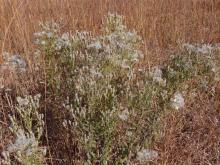

They look as though they are growing in a monoculture of Big bluestem (Andropogon gerardii), but in fact there is lots of diversity. Seen in the right foreground is an odd, late blooming Stiff goldenrod (Solidago rigida), and in the center foreground is the Liatris punctata (probably), also shown earlier. Hiding in the grass are other forbes, too.
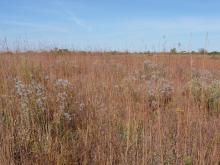
cohan (not verified)
Re: Schaefer Prairie - Minnesota
Wed, 09/26/2012 - 11:51pmThis is one of many ecotypes where the diversity requires you to get up close to see :) Many of my favourite spots locally and on trips into the foothills and mountains would just look like either grass or stones until you get in there and start walking around!
Nice to get in seed views of plants too!
Richard T. Rodich
Way back on July 4, I visited
Mon, 09/09/2013 - 9:21pmWay back on July 4, I visited Schaefer Prairie for the first time this year. Our spring was very cold and a full month late, although by this time most things were catching up, and only a couple weeks late compared to a normal season. It's always fun to see things in the wild, and pristine prairies are rare indeed. It seems there is not a lot going on at this time of year, until one looks closely.
Achillea millefolium, so common in perennial gardens here, looks just the same in the wild. Amorpha canescens is still "waking" its spring flush of foliage.
Anemone canadensis can be a thug in gardens, and in the right place on the prairie it infiltrates every square foot of real estate. But for whatever makes it happy or unhappy, this Canada Anemone seems confined to a relatively small area, leaving room for much plant diversity. Asclepias tuberosa is in bud, and Cypripedium candidum is well past flowering.
The Heleniuim autumnale are not even close to showing flower buds, but the stems are quite interesting with their decurrent leaves. This is the first time I've been here at the right time to see Iris virginca var. shrevei blooming.
Pedicularis lanceolata has a very distinctive foliage, unlike anything else on the prairies in Minnesota. Lithospermum canascens complements itself with chalky orange flowers and blue-gray foliage.
I never even knew Thalictrum dasycarpum grew here until I saw it flowering. Like so many species in the prairie, they are quite inconspicuous until they flower. This species is dioecious.
Tradescantia bracteata, I believe - I didn't thoroughly check the glandular structure for a positive determination. Bracteata is the more common species for this environment.
Years back, this was the first place I noticed the European clover, Trifolium hybridum. In fact at first I assumed it was a native, until I identified it. Much like the normally invasive Canada thistle and Quack grass that inhabit the adjacent farm fields, it doesn't seem to have the capacity to compete well in a real prairie setting.
Richard T. Rodich
I returned on July 29. Still
Thu, 09/12/2013 - 8:53pmI returned on July 29. Still very cool for summer here. Amorpha canescens in the forground, Populus tremuloides (Quaking aspen) in the background, presumably one clone, doing its thing with root sprouts. The natural ecological progression of prairie to forest, until fire comes along.
With all the wet weather and around 10 extra inches of rain over spring and summer, some prairie flora has benefited, but I’d say most didn’t like it. Asclepias incarnata is one of the winners. A little color variation in Asclepias tuberosa.
Uncommon, compared to the other Asclepias species, Asclepias syriaca (Common milkweed). Anemone cylindrica is almost as common as Anemone Canadensis.
Dalea also benefited from the extra rain and/or cooler weather. You can see in the combination photos that Dalea candida blooms slightly earlier than Dalea purpurea. I have noticed this every year.
An unusually floriferous head of Phlox pilosa, Hesperostipa spartea (Stipa spartea), Pycnanthemum tenuifolium..
Lysimachia quadrifoliaa and Monarda fistulosa.
Ratibida pinnata and Veronicastrum virginicum.
Thalictrum dasycarpum foliage and achenes.
-------------------------------------------------------------
Well, 30 pics uploaded in one post. It can be done, but I don't recommend it. At #26 I started getting script warning with each insertion, although it didn't seem to matter.
Mark McDonough
Thanks for the update Rick, a
Fri, 09/13/2013 - 5:49amThanks for the update Rick, a bounty of beautiful plants, and expertly photographed, I imagine it's a challenge to capture good photographs when plants are all mixed in amongst tall vegetation. I'd like to use the center photo of Asclepias incarnata as my Windows Desktop image for a while, my goodness what a beauty. Seeing these, it's obvious why Asclepias tuberosa and perhaps to a lesser extent, A. incarnata, have become such enduring favorites in perennial borders.
I'm equally impressed by your getting 30 pics posted all in one shot... the freedom in posting images here is one of the benefits of new NARGS Forum.
As a fan of Thalictrum, it's good seeing T. dasycarpum, in flower from your earlier post and now foliage and seed in this latest post. Another one that resonates for me is Helenium, one of the first perennials I started with as a boy (10 yrs old), I think I liked the common name of sneezeweed :-), and the fact they grew much taller than myself. There's a very good web page on this genus: http://www.helenium.net/
I'd like to have both Dalea species in the garden; I'm sad to report to Lori, once again I received no germination on D. purpurea, not sure what I'm doing wrong, perhaps I need to scarify the seed.
Also good to see Pycnanthemum, I have one in the garden (can't remember the species), which languishes in too dry a spot, yet persists and blooms, and is wonderfully aromatic, must move mine to a better spot with more moisture.
Rick, can you speak about the moisture levels in this prairie area, are there dry and moist micro-climates, under what sort of conditions is P. tenuifolium growing?
Lori S. (not verified)
Great photo essay, Rick! I
Fri, 09/13/2013 - 11:27amGreat photo essay, Rick! I will be reviewing your pix and comments more thoroughly later... to extract maximum enjoyment. :-)
[quote=Mark McD]
I'd like to have both Dalea species in the garden; I'm sad to report to Lori, once again I received no germination on D. purpurea, not sure what I'm doing wrong, perhaps I need to scarify the seed.
[/quote]
Just a quick comment. Offhand, I'd recommend scarification for all leguminous seeds - seems to work wonders.
I lost my Pycnanthemum last year (can't remember the species either), and must make a note to grow more - the strong minty fragrance was very nice, and the late bloom (at least that species was late-blooming) is always appreciated.
cohan (not verified)
Great bunch of plants, as
Tue, 09/17/2013 - 11:21amGreat bunch of plants, as Lori mentioned, worth a longer slower look. I'm always interested in prairie species, since they are mostly outside my area. The Pedicularis foliage is interesting, so unlike the ferny foliage on local sp. Lithospermum looks very choice indeed! I suppose many of these species are things that Prairie Moon would carry seed of..
Richard T. Rodich
cohan wrote:
Tue, 09/17/2013 - 8:22pm[quote=cohan]
I suppose many of these species are things that Prairie Moon would carry seed of..
[/quote]
Yes. Although Prairie Moon is Minnesota based, their sales volume has dictated that all their seed sources are not always local anymore. Still one of the better seed prairie seed companies, in my opinion.
cohan (not verified)
I have not ordered from them
Wed, 09/18/2013 - 11:52pmI have not ordered from them yet, but their site comes up occasionally re: species I'm looking into, and they do list some very interesting and not commonly offered species.
Richard T. Rodich
Schaefer Prairie contains wet
Fri, 09/13/2013 - 8:24amSchaefer Prairie contains wet and mesic prairie biomes. A few normally only dry or dry-mesic species are purported to grow there, like Bouteloua gracilis, but I have never found them. I do keep a watchful eye.
Regarding Pycnanthemum tenuifolium in particular, it definitely likes constantly moist conditions. In this prairie it seems to mostly be found at the verge of its low moisture tolerance; apparently, that is where it competes best. Most often I find it blooming like the first pic below, with an abundance of buds but few and poorly formed flowers. Except for this season, I've had to look hard for a good pic of some nicer flowers like in the second photo. The Pycnanthemum grow right along with Thalictrum dasycarpum.
Thalictrum dioicum seems to masquerade a lot in the seed exchanges as T. dasycarpum. The real T. dasycarpum has much thicker and less delicate foliage, and the leaf petiole (the part that actually connects to the stem) is very short to non-existant in all but the lowermost leaves. Of course, the flowers (both male and female) are sure telltales, but if one hasn't seen the difference, I can understand how one might be confused.
I've only grown Dalea candida from seed once in 2002, back when I took very little notes and had very little experience. This was from wild collected seed here in Minnesota. I am sure it got no more than a winter sowing or a cold moist period in the fridge. But now I wonder..... in all the years since then, I have only kept one plant and it produces thousands of seed annually. Although I remove most of the seedheads before they "fall apart", there must be hundreds that I miss each year, yet I've only had one or two volunteers in all these years. The seeds always look good and filled, but being self pollinated, I wonder how viable they really are?
Toole (not verified)
Wonderful images Rick.
Fri, 09/13/2013 - 1:44pmWonderful images Rick.
I remember growing one of the Monarda sps at one stage --a lot of colour and a bee magnet however i found it just a bit too vigorous so out it went.
however i found it just a bit too vigorous so out it went.  .
.
I currently have small plants of Allium stellatum I raised from seed last year.It will be interesting to see if i end up with any colour variations as shown in your previous postings.
Cheers Dave.
PS Just gone back into edit my post after checking that the emotions thingy works ........Yippee !!,---(I'll add another one ..Hehe !).
Longma (not verified)
Really enjoying this thread
Sat, 09/14/2013 - 9:07amReally enjoying this thread Rick and your wonderful images, .
.
I'm certainly not 'au fait' with many of the plants that you are showing, but hope that one day part of our garden will take on the feel of the areas you are showing us. Inspirational.
Trond Hoy
I have a wish (among many)
Sat, 09/14/2013 - 12:29pmI have a wish (among many) before I die - to walk in a real prairie!
Richard T. Rodich
A few more pics in the
Thu, 09/26/2013 - 3:13pmA few more pics in the prairie from a late summer visit:
Gentiana andrewsii
Liatris ligulistylis - flower, upper foliage, foliage one-quarter the way up from the base.
Colias sp. (Sulphur butterfly) on L. ligulistylis. Liatris pychnostachys
Anyone know what kind of day flying moth? this is?
Lots of different insects, most of which I don't know....
Colias sp. again, Chauliognathus pennsylvanicus (Soldier beetle) and ? on an aster.
Ripe Thalictrum dasycarpum achenes. The species' foliage becomes even more glabrous as the season progresses. Allium stellatum.
Amorpha canescens in seed. Polygonum amphibianum var. emersum is a species I would have thought would have loved all the extra rainfall this year. But it hardly even bloomed!
The only Vernonia fasiculata that I found still blooming.
Several species of Helianthus grow here, don't know which is which, though. This one in the first pic rings a wet area where sedges, Cord grass (Spartina pectinata), Water smartweed, Lobelia syphilitica and Scutellaria galericulata grow. The reddish brown on the higher land in the background is Big Bluestem (Andropogon gerardii). The stem coloring is more pronounced in the late season. It looks like a monoculture, but to assume that would be a huge mistake. And though not as colorful, Indian grass (Sorghastrum nutans) abounds also with similar hues.
Longma (not verified)
The butterfly is Colias
Fri, 09/27/2013 - 2:56amThe butterfly is Colias eurytheme and the day flying moth is Autographa precationis.
Can't see enough to ID the small black beetle on the Aster or the green beetle at top left of the third A. precationis.
Mark McDonough
Rick, your first Gentiana
Sun, 10/06/2013 - 7:05pmRick, your first Gentiana andrewsii photo should be the standard by which the species is identified, with those little fringes at the top of the "bottle", distinguishing it from the nearly identical G. clausa. Great photos, showing a lovely plant.
The white Aster (sticking to "Aster" in the "recently older" sense) looks like Aster pilosus.
Your profile pic of Allium stellatum is gorgeous with a nice full head of bloom, it seems these midwestern forms have quite a distinctive look to them, and are really attractive.
So far as Vernonia fasciculata, how tall does it grow? Doesn't look as showy as many, but might it grow more luxuriant under cultivation without competition.
Richard T. Rodich
Thanks so much for the IDs,
Fri, 09/27/2013 - 8:26amThanks so much for the IDs, Ron. I am so new to insect identification. I didn't remember seeing the black on the upper side of the wings of the Sulphur when it flew, so I wasn't going to commit. But that is what I thought it was, too.
Longma (not verified)
RickR wrote:
Mon, 09/30/2013 - 1:45pm[quote=RickR]
Thanks so much for the IDs, Ron. I am so new to insect identification.
[/quote]
Anytime Rick, .
.
http://ninnescahlife.wichita.edu/node/409
cohan (not verified)
Lots of bloom still- when
Sun, 10/06/2013 - 4:53pmLots of bloom still- when were the photos taken?
That field of sunflowers is very nice!
I've been photographing insects and arachnids on plants for the last several years, but haven't got around to trying to id many yet.. they are definitely a big part of the scene, though..
Richard T. Rodich
cohan wrote:
Sun, 10/06/2013 - 7:29pm[quote=cohan]Lots of bloom still- when were the photos taken?[/quote]
The last bunch was on a September 4th visit.
cohan (not verified)
Same date as my last trip
Wed, 10/09/2013 - 11:49amSame date as my last trip into the mountains- not surprisingly, much more in bloom where you were!